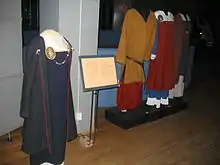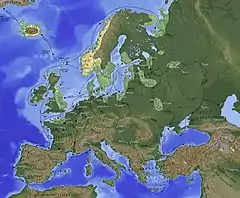Norsemen
The Norsemen (or Norse people) were a North Germanic ethnolinguistic group of the Early Middle Ages, during which they spoke the Old Norse language.[1][2][3][4] The language belongs to the North Germanic branch of the Indo-European languages and is the predecessor of the modern Germanic languages of Scandinavia.[4] During the late 8th century, Norsemen embarked on a large-scale expansion in all directions, giving rise to the Viking Age. In English-language scholarship since the 19th century, Norse seafaring traders, settlers and warriors have commonly been referred to as Vikings. The identity of Norsemen derived into their modern descendants,[5] the Danes, Icelanders,[a] Faroe Islanders,[a] Norwegians, and Swedes,[6] who are now generally referred to as 'Scandinavians' rather than Norsemen.[7]
| Part of a series on the |
| Norse people |
|---|
 |
| WikiProject Norse history and culture |
History of the terms Norseman and Northman
The word Norseman first appears in English during the early 19th century: the earliest attestation given in the third edition of the Oxford English Dictionary is from Walter Scott's 1817 Harold the Dauntless. The word was coined using the adjective norse, which was borrowed into English from Dutch during the 16th century with the sense 'Norwegian', and which by Scott's time had acquired the sense "of or relating to Scandinavia or its language, esp[ecially] in ancient or medieval times".[8] As with modern use of the word viking, therefore, the word norseman has no particular basis in medieval usage.[9]
The term Norseman does echo terms meaning 'Northman', applied to Norse-speakers by the peoples they encountered during the Middle Ages.[10] The Old Frankish word Nortmann ("Northman") was Latinised as Normannus and was widely used in Latin texts. The Latin word Normannus then entered Old French as Normands. From this word came the name of the Normans and of Normandy, which was settled by Norsemen in the tenth century.[11][12]
The same word entered Hispanic languages and local varieties of Latin with forms beginning not only in n-, but in l-, such as lordomanni (apparently reflecting nasal dissimilation in local Romance languages).[13] This form may in turn have been borrowed into Arabic: the prominent early Arabic source al-Mas‘ūdī identified the 844 raiders on Seville not only as Rūs but also al-lawdh’āna.[14]
Other names

In modern scholarship, Vikings is a common term for attacking Norsemen, especially in connection with raids and monastic plundering by Norsemen in the British Isles, but it was not used in this sense at the time. In Old Norse and Old English, the word simply meant 'pirate'.[15][16][17]
The Norse were also known as Ascomanni, ashmen, by the Germans, Lochlanach (Norse) by the Gaels and Dene (Danes) by the Anglo-Saxons.[18]
The Gaelic terms Finn-Gall (Norwegian Viking or Norwegian), Dubh-Gall (Danish Viking or Danish) and Gall Goidel (foreign Gaelic) were used for the people of Norse descent in Ireland and Scotland, who assimilated into the Gaelic culture.[19] Dubliners called them Ostmen, or East-people, and the name Oxmanstown (an area in central Dublin; the name is still current) comes from one of their settlements; they were also known as Lochlannaigh, or Lake-people.
The Slavs, the Arabs and the Byzantines knew them as the Rus' or Rhōs (Ῥῶς), probably derived from various uses of rōþs-, i.e. "related to rowing", or from the area of Roslagen in east-central Sweden, where most of the Northmen who visited the Eastern Slavic lands originated. Archaeologists and historians of today believe that these Scandinavian settlements in the East Slavic lands formed the names of the countries of Russia and Belarus.
The Slavs and the Byzantines also called them Varangians (Old Norse: Væringjar, meaning "sworn men"), and the Scandinavian bodyguards of the Byzantine emperors were known as the Varangian Guard.
Modern Scandinavian usage
In the Old Norse language, the term norrœnir menn (northern people) was used correspondingly to the modern English name Norsemen, referring to Swedes, Danes, Norwegians, Faroe Islanders, Icelanders, and others.
Modern Scandinavian languages have a common word for Norsemen: the word nordbo (Swedish: nordborna, Danish: nordboerne, Norwegian: nordboerne, or nordbuane in the definite plural) is used for both ancient and modern people living in the Nordic countries and speaking one of the North Germanic languages.
In modern Scandinavian languages, the term Northman (Norwegian: Nordmann;[20] Swedish: Norrman;[21] Danish: Nordmand [22]), although originally a term for people of the entire nordic region, is now often used to refer to people of Norwegian nationality.
Geography

The British conception of the Vikings' origins was inaccurate. Those who plundered Britain lived in what is today Denmark, Scania, the western coast of Sweden and Norway (up to almost the 70th parallel) and along the Swedish Baltic coast up to around the 60th latitude and Lake Mälaren. They also came from the island of Gotland, Sweden. The border between the Norsemen and more southerly Germanic tribes, the Danevirke, today is located about 50 kilometres (31 mi) south of the Danish–German border. The southernmost living Vikings lived no further north than Newcastle upon Tyne, and travelled to Britain more from the east than from the north.
The northern part of the Scandinavian Peninsula (with the exception of the Norwegian coast) was almost unpopulated by the Norse, because this ecology was inhabited by the Sami, the native people of northern Sweden and large areas of Norway, Finland, and the Kola Peninsula in today's Russia.
The Norse Scandinavians established polities and settlements in what are now Great Britain (England, Scotland, Wales), Ireland, Iceland, Russia, Belarus, France, Sicily, Belgium, Ukraine, Finland, Estonia, Latvia, Lithuania, Germany, Poland, Greenland, Canada,[23] and the Faroe Islands.
See also
| Wikimedia Commons has media related to Norse history and culture. |
Notes
- a Out of convenience, "Scandinavians" is commonly used as a synonym for "North Germanic peoples" even though Icelanders and Faroe Islanders do not inhabit Scandinavia today. The term is, therefore, given a cultural rather than geographical sense.
References
- Fee, Christopher R. (2011). Mythology in the Middle Ages: Heroic Tales of Monsters, Magic, and Might: Heroic Tales of Monsters, Magic, and Might. ABC-CLIO. p. 3. ISBN 978-0313027253.
"Viking" is a term used to describe a certain class of marauding Scandinavian warrior from the 8th through the 11th century. However, when discussing the entire culture of the Northern Germanic peoples of the early Middle Ages, and especially in terms of the languages and literatures of these peoples, it would be more accurate to use the term "Norse." Therefore during the Middle Ages and beyond, it therefore might be useful to speak of "German" peoples in middle Europe and of "Norse" peoples in Scandinavia and the North Atlantic.
- McTurk, Rory (2008). A Companion to Old Norse-Icelandic Literature and Culture. John Wiley & Sons. p. 7. ISBN 978-1405137386.
Old Norse' defines the culture of Norway and Iceland during the Middle Ages. It is a somewhat illogical concept as it is largely synonymous with 'Norse'... The term 'Norse' is often used as a translation of norroenn. As such it applies to all the Germanic peoples of Scandinavia and their colonies in the British Isles and the North Atlantic.
- DeAngelo, Jeremy (2010). "The North and the Depiction of the "Finnar" in the Icelandic Sagas". Scandinavian Studies. 82 (3): 257–286. JSTOR 25769033.
The term "Norse" will be used as a catchall term for all North Germanic peoples in the sagas...
- Leeming, David A. (2014). The Handy Mythology Answer Book. Visible Ink Press. p. 143. ISBN 978-1578595211.
"Who were the Norse people? The term Norse is commonly applied to pre-Christian Northern Germanic peoples living in Scandinavia during the so-called Viking Age. Old Norse gradually developed into the North Germanic languages, including Icelandic, Danish, Norwegian, and Swedish.
- Kristinsson, Axel (2010). Expansions: Competition and Conquest in Europe Since the Bronze Age. ReykjavíkurAkademían. ISBN 978-9979992219.
The same can be said of Viking Age Scandinavians who did not have a common ethnonym but expressed their common identity through the geographical and linguistic terms... There is absolutely no doubt about a common Northern identity during the Viking Age and afterwards... it even survives today.
- Kennedy, Arthur Garfield (1963). "The Indo-European Language Family". In Lee, Donald Woodward (ed.). English Language Reader: Introductory Essays and Exercises. Dodd, Mead.
[T]he pages of history have been filled with accounts of various Germanic peoples that made excursions in search of better homes; the Goths went into the Danube valley and thence into Italy and southern France ; and thence into Italy and southern France; the Franks seized what was later called France; the Vandals went down into Spain, and via Africa they "vandalized" Rome; the Angles, part of the Saxons, and the Jutes moved over into England; and the Burgundians and the Lombards worked south into France and Italy. Probably very early during these centuries of migration the three outstanding groups of the Germanic peoples—the North Germanic people of Scandinavia, the East Germanic branch, comprising the Goths chiefly, and the West Germanic group, comprising the remaining Germanic tribes—developed their notable group traits. Then, while the East Germanic tribes (that is, the Goths) passed gradually out of the pages of history and disappeared completely, the North Germanic, or Scandinavian, or Norse, peoples, as they are variously called, became a distinctive people, more and more unlike the West Germanic folk who inhabited Germany itself and, ultimately, Holland, and Belgium and England. While that great migration of nations which the Germans have named the Volkerwanderung was going on, the Scandinavian division of the Germanic peoples had kept their habitation well to the north of the others and had been splitting up into the four subdivisions now known as the Swedes, Norwegians, Danes, and Icelanders. Long after the West Germanic and East Germanic peoples had made history farther south in Europe, the North Germanic tribes of Scandinavia began a series of expeditions which, during the eighth and ninth centuries, in the so-called Viking Age especially, led them to settle Iceland, to overrun England and even annex it to Denmark temporarily, and, most important of all, to settle in northern France and merge with the French to such an extent that Northmen became Normans, and later these Normans became the conquerors of England.
- Davies, Norman (1999). The Isles: A History. Oxford University Press. ISBN 978-0198030737.
Ottar belonged to a group of peoples who were beginning to have a huge impact on European history. They are now called 'Scandinavians', though historically they were called 'Northmen'.
- "Norseman, n.", "Norse, n. and adj." OED Online, Oxford University Press, July 2018, https://www.oed.com/view/Entry/128316, https://www.oed.com/view/Entry/128312. Accessed 10 September 2018.
- "Viking, n." OED Online, Oxford University Press, July 2018, http://www.oed.com/view/Entry/223373 . Accessed 10 September 2018.
- "Northman, n." OED Online, Oxford University Press, July 2018, https://www.oed.com/view/Entry/128371. Accessed 10 September 2018.
- Michael Lerche Nielsen, Review of Rune Palm, Vikingarnas språk, 750–1100, Historisk Tidskrift 126.3 (2006) 584–86 (pdf pp. 10–11) (in Swedish)
- Louis John Paetow, A Guide to the Study of Medieval History for Students, Teachers, and Libraries, Berkeley: University of California, 1917, OCLC 185267056, p. 150, citing Léopold Delisle, Littérature latine et histoire du moyen âge, Paris: Leroux, 1890, OCLC 490034651, p. 17.
- Ann Christys, Vikings in the South (London: Bloomsbury, 2015), pp. 15–17.
- Ann Christys, Vikings in the South (London: Bloomsbury, 2015), pp. 23–24.
- "Viking, n.". Oxford English Dictionary. Oxford University Press. 2018. Retrieved 10 September 2018.
- Cleasby, Richard; Vigfusson, Gudbrand (1957). "víkingr". An Icelandic–English Dictionary (2nd edition by William A. Craigie ed.). Oxford University Press.
- Bosworth, Joseph; Northcote Toller, T. (1898). "wícing". An Anglo-Saxon Dictionary. Oxford University Press.
- Richards, Julian D. (2005). Vikings : A Very Short Introduction. Oxford University Press. pp. 15–16. ISBN 978-0191517396. Retrieved 7 February 2018.
- Baldour, John Alexander; Mackenzie, William Mackay (1910). The Book of Arran. Arran society of Glasgow. p. 11.
- https://ordbok.uib.no/perl/ordbok.cgi?OPP=nordmann&ant_bokmaal=5&ant_nynorsk=5&begge=+&ordbok=begge
- https://svenska.se/tre/?sok=norrmann&pz=1
- https://ordnet.dk/ddo/ordbog?query=nordmand
- Linden, Eugene (December 2004). "The Vikings: A Memorable Visit to America". Smithsonian Magazine. Archived from the original on September 24, 2015.